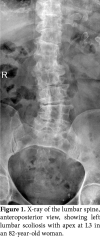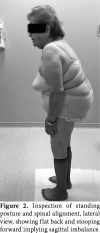Rehabilitation in adult spinal deformity
- PMID: 33089079
- PMCID: PMC7557622
- DOI: 10.5606/tftrd.2020.6225
Rehabilitation in adult spinal deformity
Abstract
Adult spinal deformity causes significant health-related problems such as pain and disability in adults. Currently, there are several non-operative management strategies such as pain medications, physical modalities, exercises, bracing or interventional procedures. Specific exercises including strengthening of back and abdominal muscles, neuromuscular re-education for daily tasks, and active self-correction are vital to improve postural control and spinal stability. Bracing for a few hours a day can help reduce pain and provide spinal stability in adults. In case of severe disability and pain unresponsive to non-operative treatments, spinal fusion with instrumentation is an alternative. Postoperative rehabilitation can help to reduce pain and disability and improve return to activity or work. Protecting the spine early after surgery and timing of initiation of exercises with respect to osseointegration and bone remodeling phases are important principles of postoperative rehabilitation. In this review, rehabilitation in adult spinal deformity is discussed in the light of the literature.
Keywords: Adult spinal deformity; bracing; degenerative scoliosis; exercise; rehabilitation; spinal fusion.
Copyright © 2020, Turkish Society of Physical Medicine and Rehabilitation.
Conflict of interest statement
Conflict of Interest: The author received no financial support for the research and/or authorship of this article.
Figures







Similar articles
-
[Spinal instrumentation, source of progress, but also revealing pitfalls].Bull Acad Natl Med. 2003;187(3):523-33. Bull Acad Natl Med. 2003. PMID: 14556467 Review. French.
-
Impact of Physical Therapy on Pain and Function in a Patient With Scoliosis.Cureus. 2021 May 26;13(5):e15261. doi: 10.7759/cureus.15261. Cureus. 2021. PMID: 34188999 Free PMC article.
-
Comprehensive study of back and leg pain improvements after adult spinal deformity surgery: analysis of 421 patients with 2-year follow-up and of the impact of the surgery on treatment satisfaction.J Neurosurg Spine. 2015 May;22(5):540-53. doi: 10.3171/2014.10.SPINE14475. Epub 2015 Feb 20. J Neurosurg Spine. 2015. PMID: 25700238
-
Factors influencing the evaluation and management of neuromuscular scoliosis: A review of the literature.J Back Musculoskelet Rehabil. 2016 Nov 21;29(4):613-623. doi: 10.3233/BMR-160675. J Back Musculoskelet Rehabil. 2016. PMID: 26966821 Review.
-
Long-term results of iliac wing fixation below extensive fusions in ambulatory adult patients with spinal disorders.J Spinal Disord Tech. 2010 Oct;23(7):e37-42. doi: 10.1097/BSD.0b013e3181cc8e7f. J Spinal Disord Tech. 2010. PMID: 20124910
Cited by
-
Editorial: Using Motion Analysis Techniques and Musculoskeletal Modeling of the Spine to Better Understand Spinal Disorders and Evaluate Treatment Effects.Front Bioeng Biotechnol. 2022 Apr 6;10:884123. doi: 10.3389/fbioe.2022.884123. eCollection 2022. Front Bioeng Biotechnol. 2022. PMID: 35464729 Free PMC article. No abstract available.
-
Conservative Treatment in Adult Degenerative Scoliosis: a Prospective Cohort Study.Maedica (Bucur). 2024 Mar;19(1):23-29. doi: 10.26574/maedica.2024.19.1.23. Maedica (Bucur). 2024. PMID: 38736938 Free PMC article.
-
Salivary Progesterone Levels in Female Patients with a History of Idiopathic Scoliosis: A Retrospective Cross-Sectional Study.Clin Pract. 2022 May 11;12(3):326-332. doi: 10.3390/clinpract12030038. Clin Pract. 2022. PMID: 35645315 Free PMC article.
-
Letter to the Editor concerning "Does the use of postoperative brace help preventing mechanical complications following adult deformity surgery?" by J. Pizones et al. (Eur Spine J [2023]; doi: 10.1007/s00586-022-07521-3).Eur Spine J. 2023 Aug;32(8):2932-2933. doi: 10.1007/s00586-023-07794-2. Epub 2023 Jun 3. Eur Spine J. 2023. PMID: 37270435 No abstract available.
-
Effect of gluteal muscle strengthening exercise on sagittal balance and muscle volume in adult spinal deformity following long-segment fixation surgery.Sci Rep. 2022 May 31;12(1):9063. doi: 10.1038/s41598-022-13190-5. Sci Rep. 2022. PMID: 35641598 Free PMC article.
References
-
- Silva FE, Lenke LG. Adult degenerative scoliosis: evaluation and management. E1Neurosurg Focus. 2010;28 - PubMed
-
- Aebi M. The adult scoliosis. Eur Spine J. 2005;14:925–948. - PubMed
-
- Kebaish KM, Neubauer PR, Voros GD, Khoshnevisan MA, Skolasky RL. Scoliosis in adults aged forty years and older: prevalence and relationship to age, race, and gender. Spine (Phila Pa 1976) 2011;36:731–736. - PubMed
-
- Carter OD, Haynes SG. Prevalence rates for scoliosis in US adults: results from the first National Health and Nutrition Examination Survey. Int J Epidemiol. 1987;16:537–544. - PubMed
-
- Robin GC, Span Y, Steinberg R, Makin M, Menczel J. Scoliosis in the elderly: a follow-up study. Spine (Phila Pa 1976) 1982;7:355–359. - PubMed
Publication types
LinkOut - more resources
Full Text Sources
